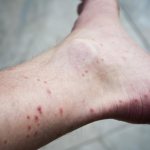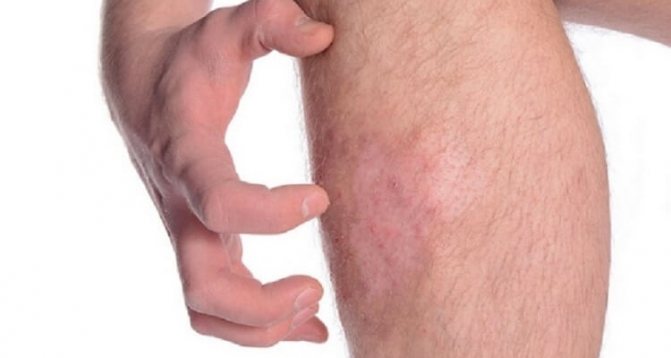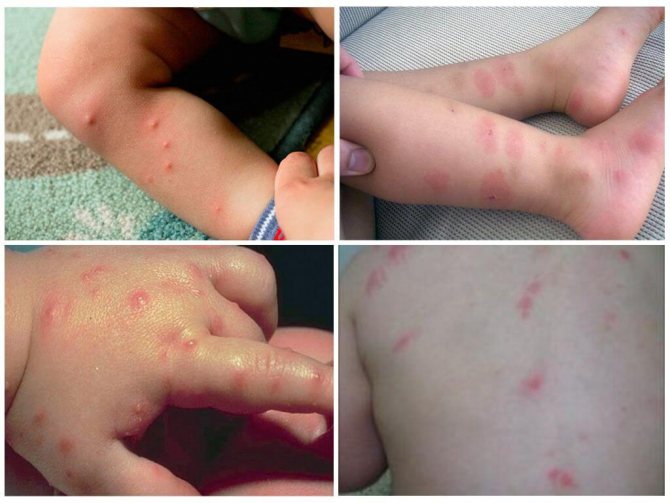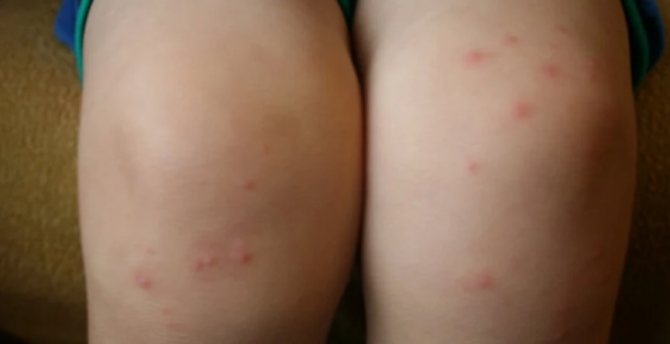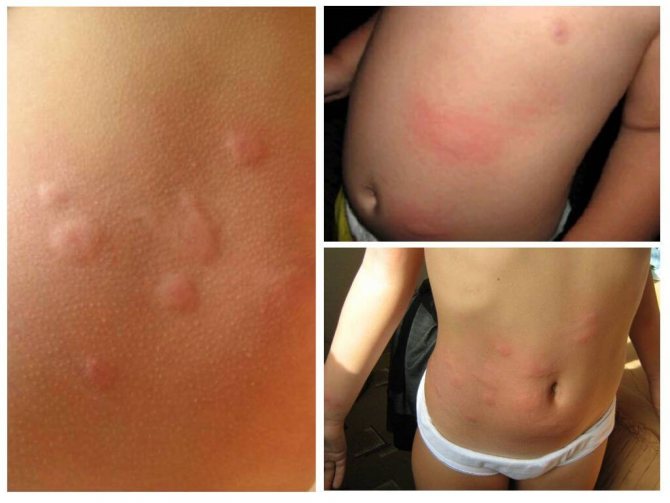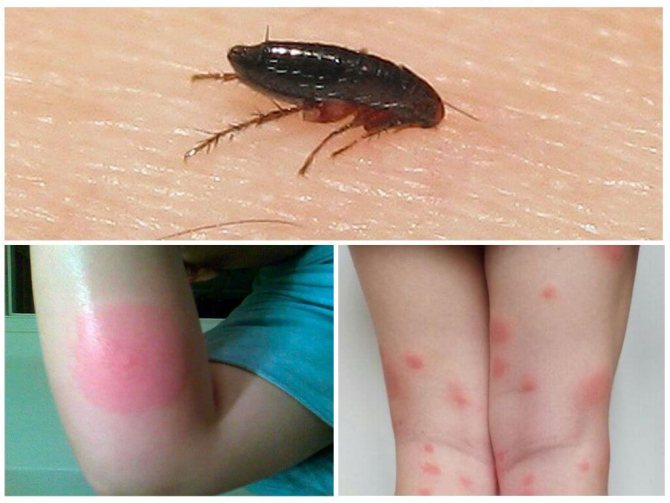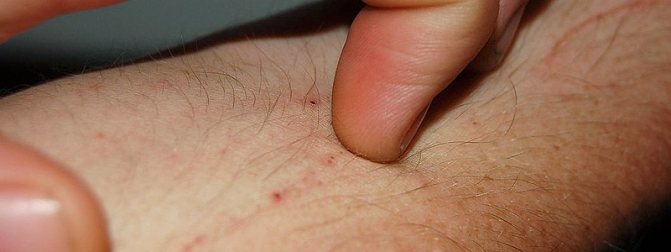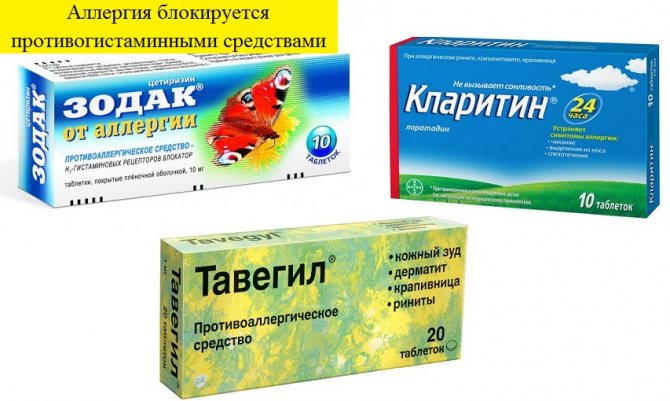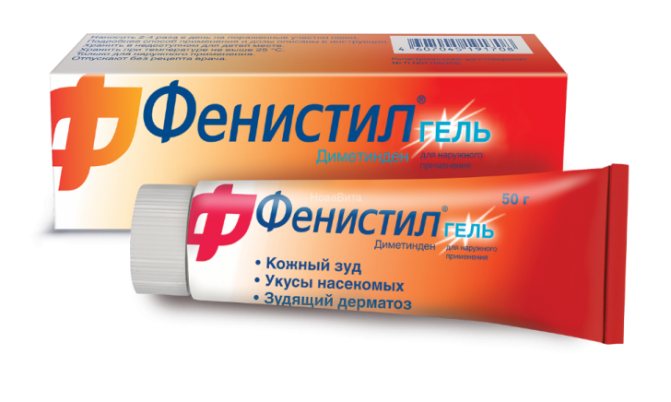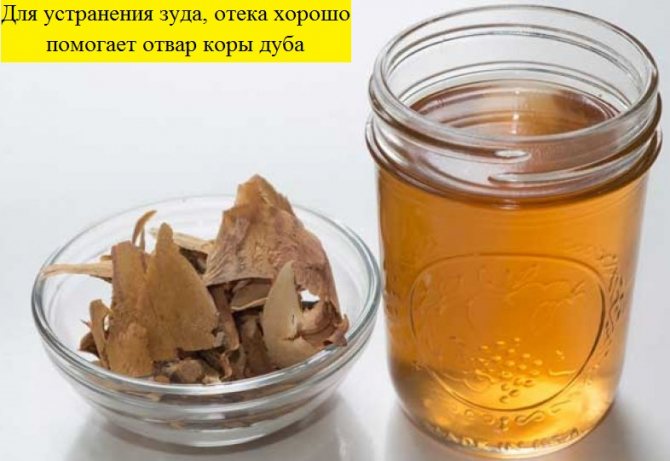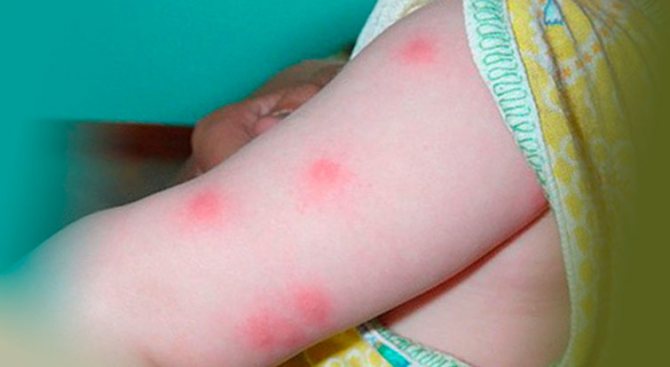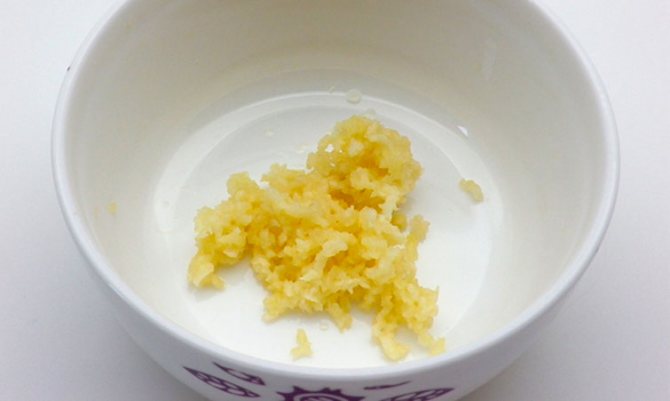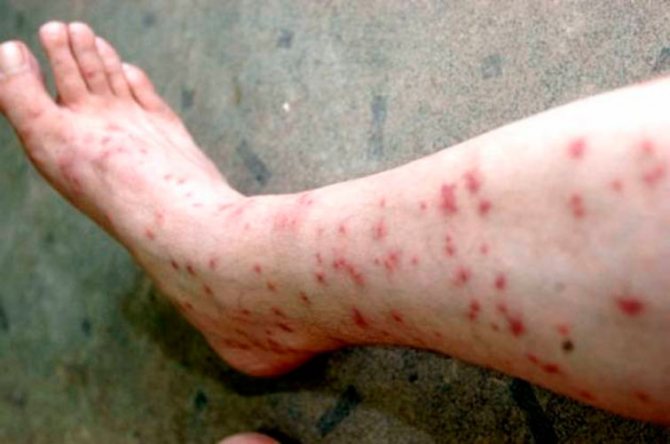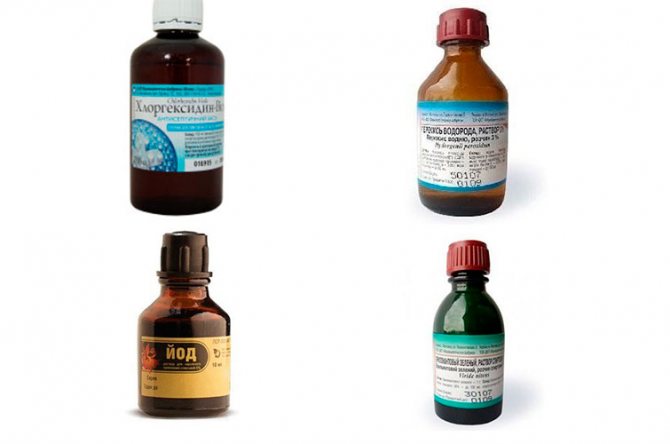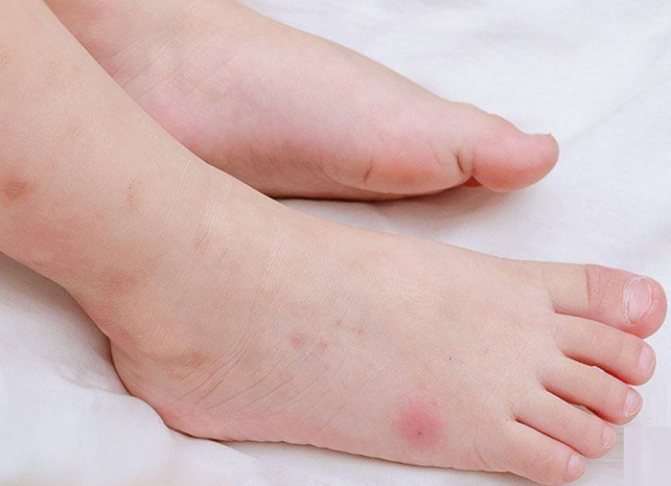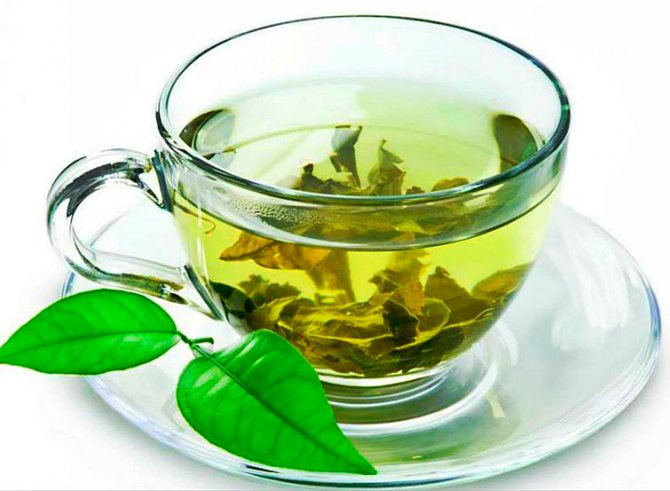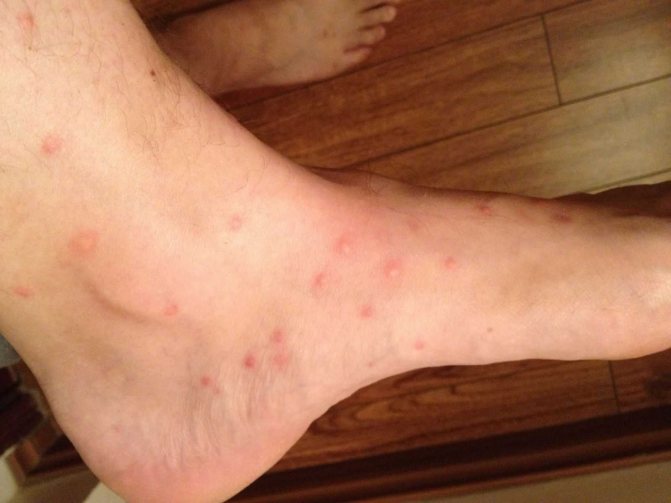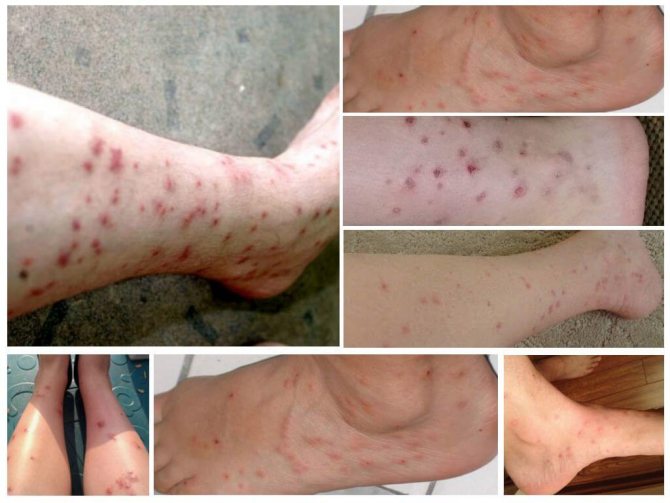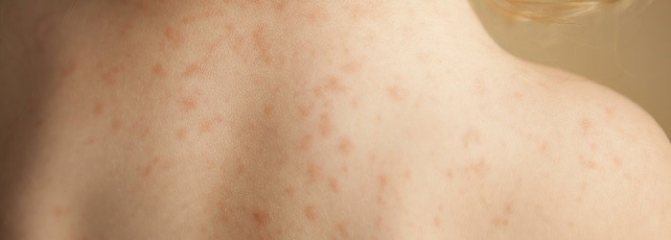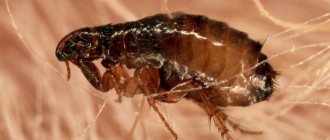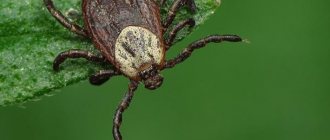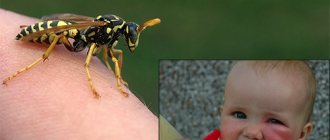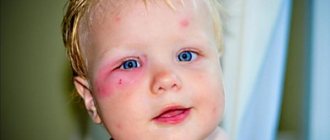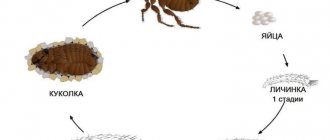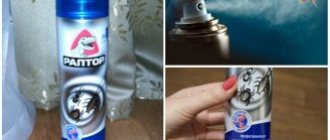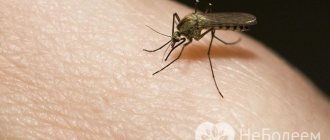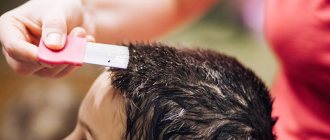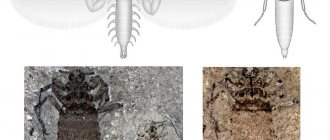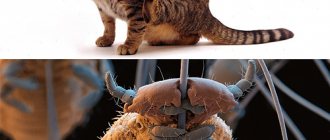Allergy in adults and children to flea bites. How to recognize flea bites. What are the symptoms of allergic reactions? How dangerous is an allergy for humans. The use of drugs, folk remedies and treatment features.
We know very well such blood-sucking parasites as fleas. They are able to deliver enormous trouble to animals and humans, in the form of painful bites and unbearable itching. In addition, they are carriers of infections, which classifies them as dangerous parasites.
The human body can react in different ways to the attack of bloodsucking, some people tolerate the bite quite easily, some may develop an allergy to flea bites, which is dangerous with serious complications.
general information
The appearance of allergies in humans is a manifestation of the body's reaction. There are a large number of flea species that attack both animals and humans. Each type has its own characteristics. Thanks to the reaction of the body, we can pay attention to the problem in time and take the necessary measures.
When a sand flea attacks, a person feels severe pain, bite marks appear on the skin. Females are very dangerous, they do not just bite people, but penetrate under the skin. Rat fleas, which carry encephalitis, plague and typhus, are very dangerous. Concerning severe allergic reactions, they occur in rare cases when individuals of this species are attacked. How the parasites look can be seen in the photo.
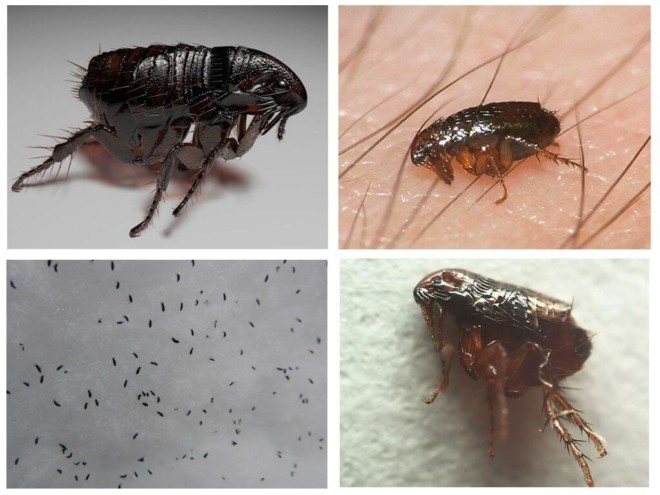
Most often, people are allergic when attacked by cat and dog fleas. If pets live in the apartment, they need protection from bloodsucking during walks. It is also necessary to regularly examine the pet and take action immediately if it becomes infected. Since the bite is always accompanied by severe itching, there is always a threat of infection when scratching the wounds.
Pathologies are dangerous with severe complications and, in the absence of proper treatment, can lead to anaphylactic shock.
Protecting your pet while walking
Fleas are carried by animals. Insects often parasitize warm-blooded mammals: it is easier to hide in a thick layer of wool. A person is attacked in exceptional cases.
During walks, parasites can infect a pet. From the first days of defeat, the pet is actively combing its body. Most often, sick or elderly pets are susceptible to flea bite allergies.
Eliminate the risk of infection of pets will allow the use of drugs that protect the skin from bites. In zoological stores, there is a wide selection of products that are rubbed into the woolen cover. Their effect lasts for several weeks. After the expiration of the term, the procedure must be repeated.
If the pet's health has noticeably deteriorated, the owners need to contact the veterinarian. The specialist will give recommendations and develop a treatment program.
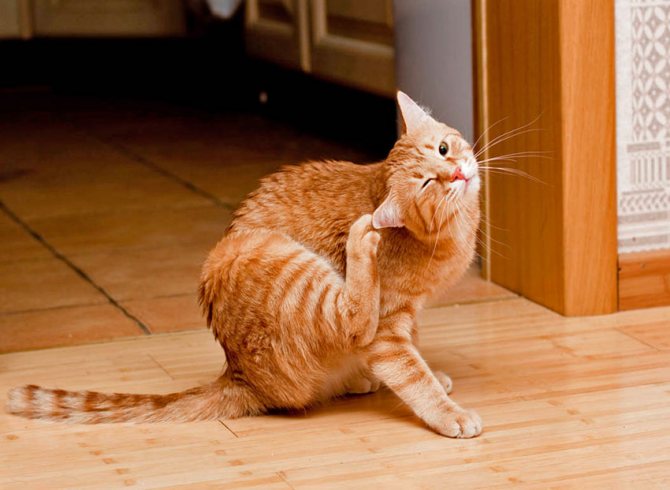

How to tell if a flea bite
The unconditional difference between the bite of this bloodsucking is acute pain during the attack. The fact is that these parasites, when piercing the skin, do not secrete any anesthetic enzymes, such as ticks, mosquitoes, bedbugs. Therefore, the first sign is pain. They resemble a puncture with a needle.A red spot appears at the site of the attack, in some cases, a wound resembling an abscess may appear.
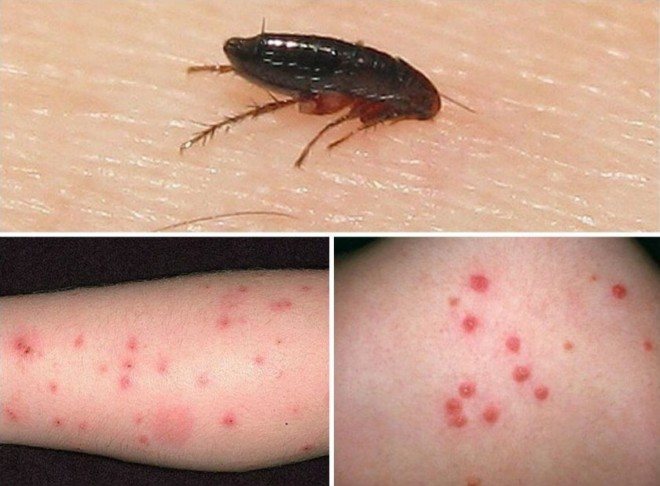

When a flea attacks a person, it lets in enzymes into the wound that cause a reaction in the body. For this reason, the place swells a little, there is severe itching. Unlike a mosquito bite, these take a very long time. Even if you do not touch the affected area and do not comb, the wound will heal for several days. In some cases, inflammation and wound suppuration may develop.
What infections can fleas carry?
Sometimes incompetent people scoff at flea bites. And this is fundamentally wrong, since insects are capable of carrying infections, sometimes leading to death. And even more so, flea bites in a child. The most common flea-borne diseases are:
- encephalitis;
- plague;
- typhus;
- anthrax;
- tape type of helminths;
- infections caused by a fungus;
- listeriosis;
- salmonellosis;
- hepatitis.
In addition, blood-sucking insects are carriers of worms and other helminths.
Fleas in a child and an adult infect the body through saliva that enters the bloodstream. Moreover, the baby, with its own hands, brings the infection under the skin, combing the bite site. He gets it in the process of playing with animals, walking on the street, flipping through magazines and books. Internal organs, liver, and gastrointestinal tract become infected.
Where are fleas enriched with numerous infections and microbes, which are then passed on to children and adults? This is not difficult to understand. Individuals bite not only healthy, but also sick individuals and even the dead. From here, infections that are transmitted to children are taken.
Insects bite not only the owner, they attack any warm-blooded creature.
Parasites can transmit blood-borne bacterial infections:
- plague stick;
- antiseptic bacillus;
- salmonella bacteria.
During a bite, helminth eggs can enter the bloodstream, since fleas are the intermediate host of dirofilariae.
Dirofilariae are round worms. When an infected animal bites, the bloodsucker becomes infected with the larvae (microfilariae) of parasites. After 2 weeks, the larva migrates to the oral apparatus of the flea, reaching the invasive stage. After a bite, dirofilariae fall under the skin, from where they begin to migrate through the child's body.
Symptoms of dirofilariasis depend on the location of the nematodes parasitizing in the heart muscle, lungs, eyes, or under the skin:
- heart, pulmonary failure;
- hemoptysis;
- swelling of the eyelids;
- tearing;
- increased intraocular pressure;
- nodules under the skin.
The life cycle of dirofilaria is up to 2 years.
The female lays up to 500 eggs in the genital crevices, animal litters. Flea development cycle: egg-larva-pupa-adult. The duration of the cycle depends on external conditions: under favorable conditions it will be 16 days, under unfavorable conditions - up to 1.5 years. For insect reproduction, adverse factors are low humidity (up to 50%) and high air temperature (above 25 degrees).
The child should not be allowed to come into contact with stray animals on the street. Pets (cats, dogs, hamsters, guinea pigs) should regularly undergo anti-blanket treatment. The dwelling must be disinfected with drugs to destroy not only insects, but also larvae.
Typical symptoms
Symptoms include various manifestations, the affected area swells, itching appears, which lasts for a long time until the wound heals. The wound does not heal for 3-4 days. Most often, parasites attack the legs, but bites are also possible on other parts of the body.
When parasites bite sleeping people, there may be affected areas of the body in the neck, armpits, arms. One individual inflicts several bites, so you can notice wounds on the body that are at a distance of 1-2 centimeters from each other.
Quite often, people have an increase in lymph nodes, an increase in body temperature. Hives may also appear. There are cases when anaphylactic shock and Quincke's edema developed. Medical assistance is required in such situations, since a lethal outcome is possible.
Infection with helminths
Parasites are becoming the main cause of helminth infection. There are two types of these problems that are worth looking into in more detail.
Dipylidiosis
The tapeworm is the causative agent of this type of helminthiasis. Arctic foxes, cats, dogs and other animals face similar diseases. Tapeworm larvae are found in fleas that live on pets. If a parasite accidentally gets into a person's mouth, it will become infected. In just 20 days, the worm can grow up to 70 centimeters in length. The disease is asymptomatic, but you should be alerted by the following signs:
- painful sensations in the abdomen, diarrhea;
- lack of sleep and appetite;
- allergic reactions;
- abrupt changes in behavior.
Hymenolepiasis
The rat chain is the causative agent of this disease. The flea larva swallows the helminth egg, so a worm begins to develop in it. If a flea gets into the mouth of a person, it will instantly become infected. The disease proceeds without pronounced symptoms, but in the event of sharp pain in the stomach, an urgent need to go to the doctor. If there are too many worms in the body, then weight may begin to disappear, and the anus is very itchy. Such a tapeworm grows up to 60 centimeters in length in a minimum time.
Symptoms when attacking a child
The child's body is much weaker and the reaction to the attack of the bloodsucking is manifested in a more severe form. The child becomes very irritated, agitated, capricious. He is tormented by bites, and he cannot play normally, sleep, rest, the baby cries and can even show aggression.
The body temperature rises, stool disorders are observed, difficulty breathing can be observed. Urticaria may appear. In some cases, symptoms of intoxication appear, the child is very weak, sleepy, does not want to play, does not show interest in others, nausea and vomiting appear.
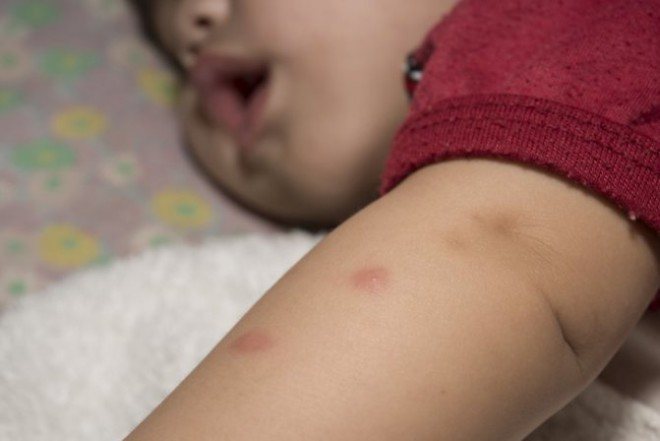

The affected areas on the body take a very long time to heal, the child suffers from severe itching. When the parasite attacks the wound with enzymes, they enter the blood, which changes its composition.
First aid
To protect yourself, prevent serious consequences and get rid of acute symptoms, you need to take some action. Remember that bites are very dangerous to humans and can have serious consequences.
The first thing to do is rinse your skin. The affected skin should be washed with warm water and laundry soap. In this case, laundry soap is simply irreplaceable. This creates a kind of barrier that prevents bacteria from entering the wound.
Be sure to treat the wounds with any available antiseptic. You can use brilliant green, hydrogen peroxide, iodine. This will prevent the development of inflammatory processes and wound suppuration. Medicines are used that are designed to stimulate regeneration processes. Calamine lation or sulfuric ointment is used.
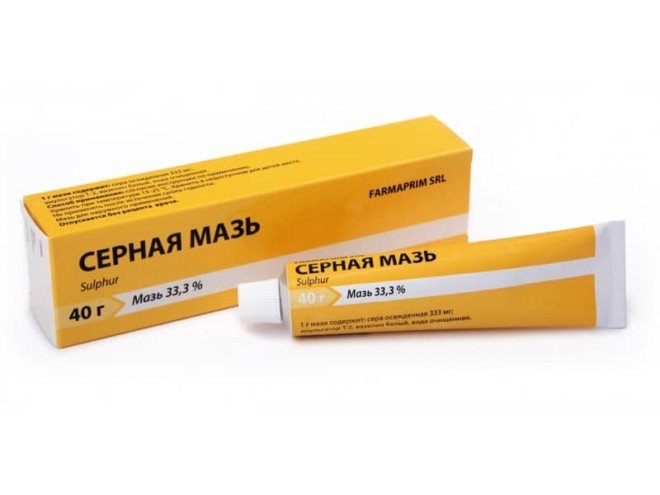

In the event that the development of Quincke's edema is observed, be sure to immediately call an ambulance. The person needs to be reassured, preferably in a sitting position. The child needs to be picked up and all measures taken to calm him down.
The patient must be transferred to a clean room, where there is no source of the allergen. All items from the neck area must be removed, chains, tie, etc. It is also necessary to take off tight clothes, it is impossible for clothes to come into contact with the neck.The patient needs to be given a large amount of water, soda solutions or mineral water can be used.
Reducing the risk of attacks by dangerous insects
It is important to know not only what to do if a flea has bitten and a reaction appears in the form of itching and other signs in a person. It is better to try to prevent the appearance of human and any other flea bites on the child.
Several preventive measures to prevent the appearance of insects in the house and minimize the likelihood of contact with them in other places where they congregate:
- Make sure that pets do not come close to wild animals (mice, rats, hedgehogs, moles, foxes), do not come into contact with infected rugs or bedding, do not run into suspicious rooms or basements.
- As a preventive measure, comb the fur of your pets, and be sure to bathe the animals using flea shampoo, doing this regularly.
- Invite specialists from the SES for the complete treatment of the apartment with means for the destruction of parasites.
- Vacuum carpets and upholstered furniture more often, treat housing with special disinfectants, especially in places where the animal is often found, and also wash the bedding frequently.
- To repel fleas, you can use essential oils (wormwood, eucalyptus, pine, thyme, tea tree, cedar, peppermint), repellents. Care should be taken with such processing of the room if very young children or pregnant women live in the building.
- Avoiding dampness and high humidity in the room is a good breeding ground for fleas. Constantly ventilate the room, isolate sources of dampness. If it is not possible to eliminate the cause completely, it is worth installing an additional heating unit or air dryer.
- Do not allow children to play with stray animals and bring them into the house.
- On the beaches of tropical countries, it is better not to appear in the early morning during the greatest flea activity, sit not on the sand, but on a sun lounger and be sure to wear closed shoes when walking on the sand. Do not neglect repellents purchased in the country of location, and wash your feet every night.
You can only help your kids not to face such troubles by carefully observing the above rules. There are enough dangers in the world that lie in wait for children, and our task is to protect as much as possible from them. After all, what could be better than a healthy, happy and smiling child!
Traditional methods
To get rid of severe itching, relieve severe inflammation and slightly improve the condition of the skin, you can use baking soda. To do this, dissolve 1 teaspoon of baking soda in a glass of warm water. Next, wipe the affected areas with a cotton swab. This procedure must be done three times a day.
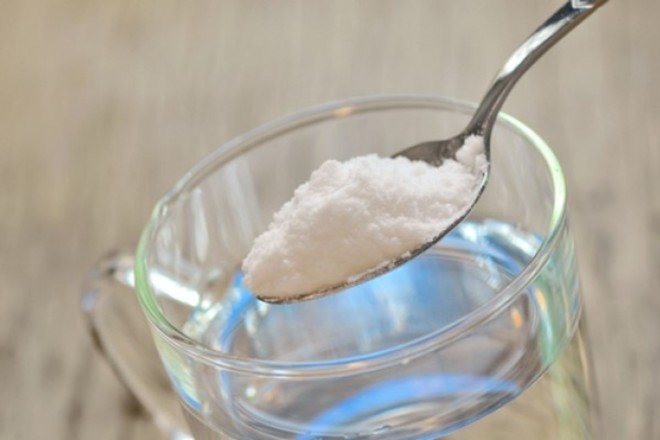

If swelling and inflammation appear on the skin, you can use regular ice. You need to take a piece of gauze or any cloth and wrap several pieces of ice in them. Then just apply and wipe the wounds a little. It will also help relieve itching a little.
Calendula, plantain, celandine, parsley, dandelion, green tea have a good effect on the skin. Decoctions are prepared from them and the affected areas of the skin are wiped. It relieves inflammation, swelling, soothes the skin and promotes rapid healing. The procedure is carried out 2 times a day.
The use of drugs
As mentioned earlier, drugs can only be prescribed by a doctor, after examination and health assessment. The most commonly prescribed drugs are Flucinar or Hydrocortisone. These are steroid ointments that help relieve pain and itching. Also, to get rid of unbearable itching, topical ointments are recommended, these include Fenistil.
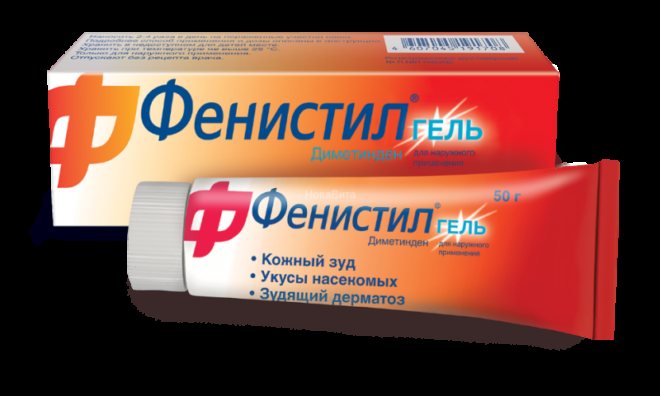

Antihistamines are recommended for other symptoms. These medicines include Tavegil, Zodak. When the allergy is severe, Suprastin, Ketotifen are prescribed.Severe pains are also possible, which are relieved by pain relievers, for example, Diclofenac.
Treatment of children
Do not use drugs for children that are prescribed to adult patients. This is due to the concentration, dosage, active ingredients that are in the drugs. The drugs are prescribed only taking into account the patient's age, weight, health status.
In this case, the affected areas are treated with hydrogen peroxide or Chlorhexidine. Alcohol solutions are also used for processing. Antihistamines can be prescribed, they are dispensed from pharmacies only with a prescription. To relieve pain and get rid of itching, the child is prescribed ointments for external use.
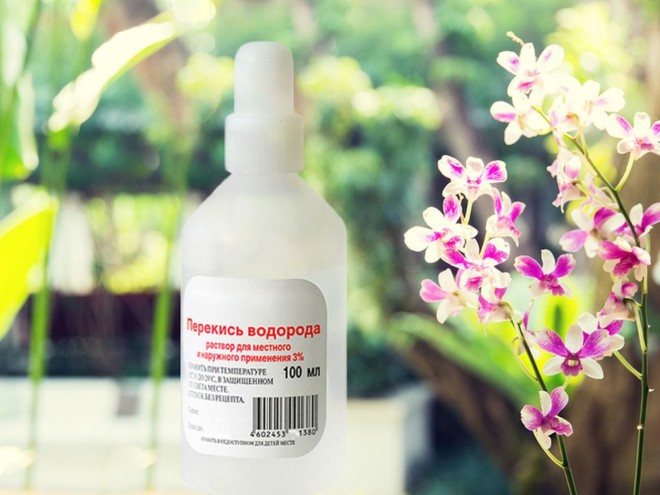

Folk remedies can also be used, but only after agreement with the attending physician. For example, you can use a mixture of lemon juice and honey, from which compresses are made. Decoctions of calendula, plantain, mint, bird cherry are also used. A fairly effective method is a mixture of soda and ammonia.

